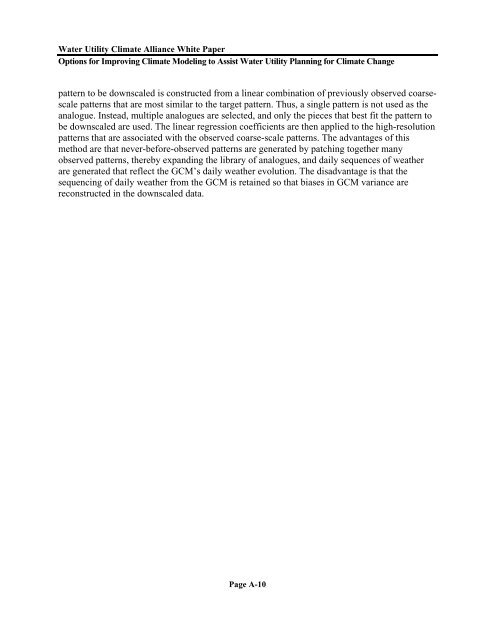Options for Improving Climate Modeling to Assist Water Utility ...
Options for Improving Climate Modeling to Assist Water Utility ...
Options for Improving Climate Modeling to Assist Water Utility ...
Create successful ePaper yourself
Turn your PDF publications into a flip-book with our unique Google optimized e-Paper software.
<strong>Water</strong> <strong>Utility</strong> <strong>Climate</strong> Alliance White Paper<br />
<strong>Options</strong> <strong>for</strong> <strong>Improving</strong> <strong>Climate</strong> <strong>Modeling</strong> <strong>to</strong> <strong>Assist</strong> <strong>Water</strong> <strong>Utility</strong> Planning <strong>for</strong> <strong>Climate</strong> Change<br />
pattern <strong>to</strong> be downscaled is constructed from a linear combination of previously observed coarsescale<br />
patterns that are most similar <strong>to</strong> the target pattern. Thus, a single pattern is not used as the<br />
analogue. Instead, multiple analogues are selected, and only the pieces that best fit the pattern <strong>to</strong><br />
be downscaled are used. The linear regression coefficients are then applied <strong>to</strong> the high-resolution<br />
patterns that are associated with the observed coarse-scale patterns. The advantages of this<br />
method are that never-be<strong>for</strong>e-observed patterns are generated by patching <strong>to</strong>gether many<br />
observed patterns, thereby expanding the library of analogues, and daily sequences of weather<br />
are generated that reflect the GCM’s daily weather evolution. The disadvantage is that the<br />
sequencing of daily weather from the GCM is retained so that biases in GCM variance are<br />
reconstructed in the downscaled data.<br />
Page A-10

















